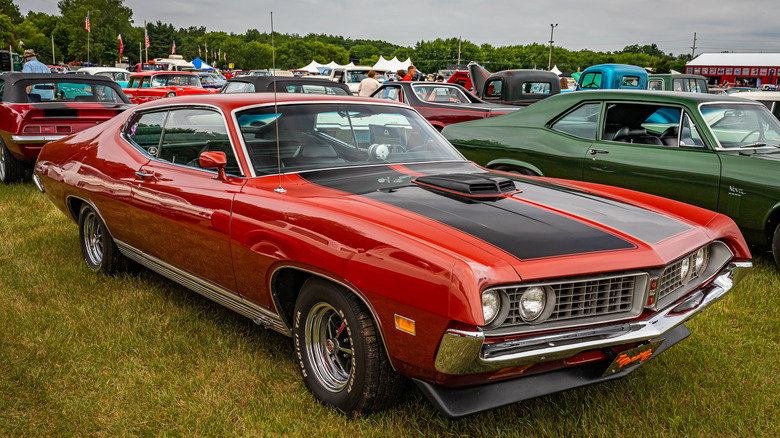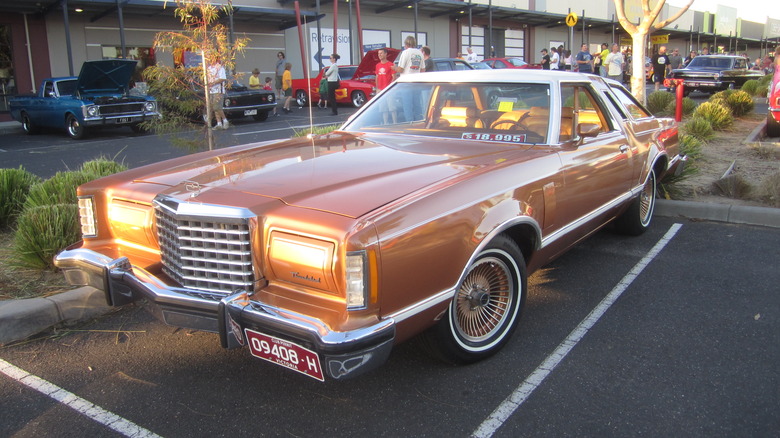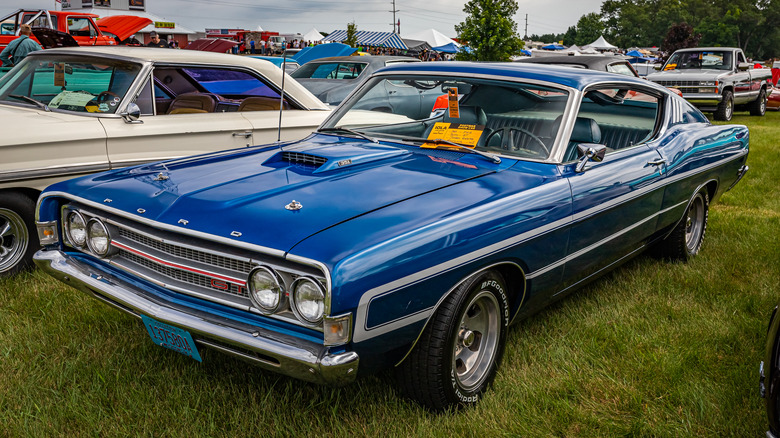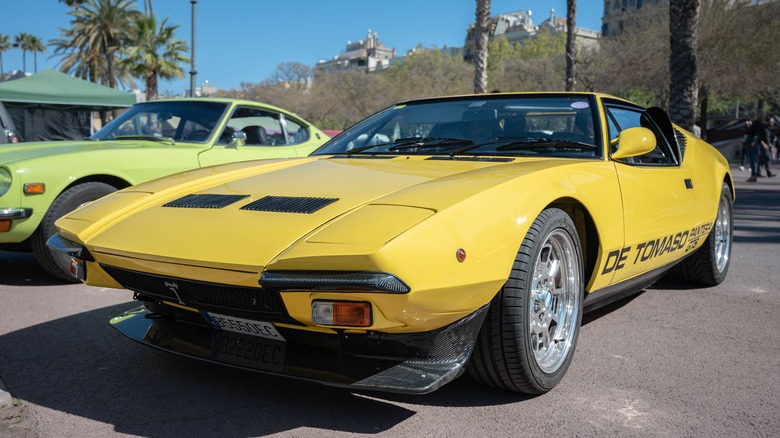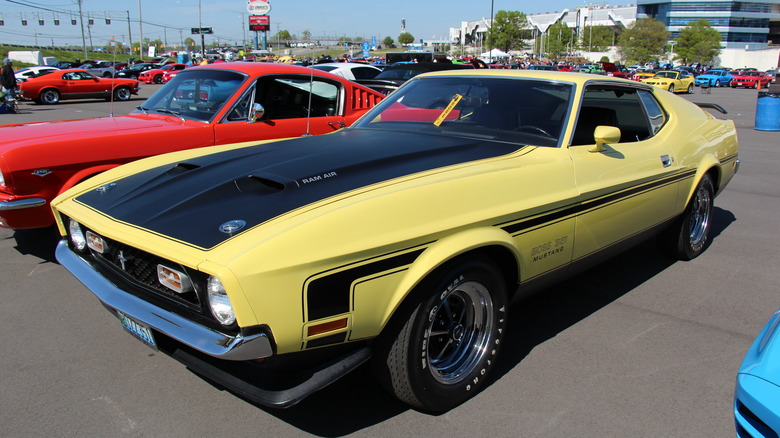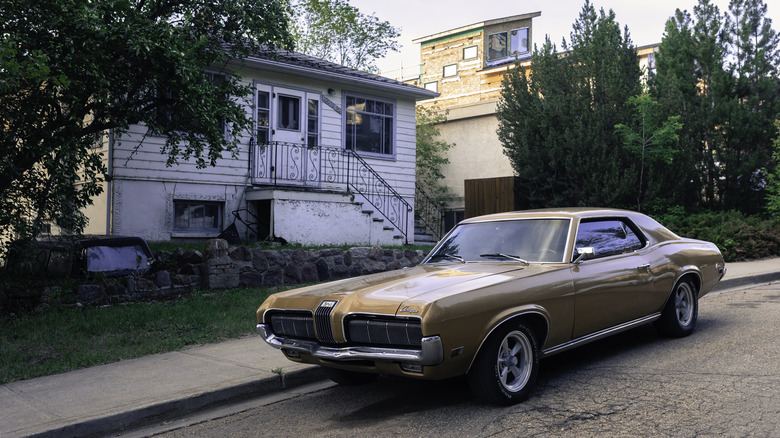5 Of The Coolest Cars Equipped With Ford's 351 V8 Engine
The 351 V8 engines are some of the best-known motors made by Ford, but even Ford fans might not know they came in three distinct types: Windsor, Cleveland, and Modified. The engines may be the same size, but in other ways they couldn't be more different.
The Windsor engine started life, reasonably enough, in Windsor, Ontario. The Canadian plant is probably the most widely used of the 351s, appearing in a range of Ford models, from muscle cars like the Mustang to classic Bronco and F-150 trucks. The Cleveland engine, made in its namesake Ohio city, was built for speed and is now the rarest of the 351s, making it a major target for collectors. The "Modified" engine split the difference, representing Ford's attempt to deliver Windsor reliability with Cleveland power. For the purposes of this article, we'll be focusing on the Windsor and Cleveland.
Each engine has its own story. The Windsor is everywhere. The Cleveland was built for speed. The cars that came equipped with them each have stories of their own. Here are 5 of the coolest rides with Ford's 351 Windsor or Cleveland engines.
1977-1979 Ford Thunderbird
The Ford Thunderbird, or "T-Bird," started in 1955 to take on the Chevrolet Corvette. Originally a sleek two-seater with a potent V8 engine, in 1958 Ford redesigned it into a four-seat luxury model. This new look turned heads and got the T-Bird Motor Trend's 1958 Car of the Year award. The Thunderbird settled nicely into Ford's lineup as a high-power, high-comfort luxury beast and would stay there for years, undergoing only iterative changes. In 1977, however, Ford took on new environmental regulations and a fuel-conscious marketplace, stripping back the T-Bird by nearly a thousand pounds. It was this version of the T-Bird that boasted the Cleveland V8 as a high-performance option. The standard was still the 302 cubic-inch V8.
Equipped with the 351 V8 engine, the Thunderbird was recognized for its performance, while the car's design highlighted personal luxury for Ford fans. Its plush interior could easily accommodate four adults, and the T-top option available in certain models added to its appeal.
Ford's strategy to downsize the Thunderbird without compromising on luxury paid off, making the late '70s models some of the most successful in the Thunderbird lineage. The introduction of the 351 V8 engine played a pivotal role in this success, too, hitting a perfect balance of performance and style.
[Featured image by Sicnag via Wikimedia Commons | Cropped and scaled | CC BY 2.0 ]
Ford Torino
The Ford Torino, first made in 1968, may have begun life as a fancified Fairlane, but it quickly established its own place among Ford thoroughbreds. The Torino was incredibly flexible, coming with a variety of powertrains from economical straight-6 engines to powerful V8s. The latter sported a 351 Cleveland engine and rode it to glory. There's even a 1968 Ford Torino in Charlotte's NASCAR Hall of Fame.
As it evolved through its generations, the Torino's design and engineering received significant updates that kept it at the forefront of the muscle car era. By the time the third generation rolled off the assembly line in 1972, the Torino had a more muscular and refined aesthetic, made evident by a restyled grille, increased chrome trim, and the introduction of models like the Gran Torino Elite in 1974. This particular year emphasized V8 exclusivity, dropping smaller engines in favor of performance-focused powertrains that ranged up to 255 horsepower. Inside, it was roomy and comfortable, with nice seats and a good-looking dashboard.
The Torino is also a classic of pop culture. Starsky and Hutch fought crime from their 1976 Ford Gran Torino, bright red with a white side stripe. Even though the actors in the show didn't love maneuvering the massive Gran Torino around the "Starsky and Hutch" set, the car is still a '70s icon.
De Tomaso Pantera
Back in the '70s, Alejandro De Tomaso, a race car driver turned carmaker from Argentina, challenged the supercar dominance of Ferrari and Lamborghini with a moderately priced competitor. The result was a sleek, visually pleasing sports car called the Pantera. That supercar power came straight from a 351 Cleveland V8.
The Pantera was designed by an Argentinian and made in Italy, but it had the heart of an American muscle car. The specs were impressive for its time, with early models pushing around 330 horsepower, enabling a sprint from 0 to 60 mph in just 5.5 seconds. It wasn't just straight-line performance that made the Pantera a great car. The Pantera was built to move, equipped with a ZF 5 speed manual transmission, independent suspension, and disc brakes on all four wheels.
The Pantera faced challenges over the years, like the oil crisis in the '70s and new emission rules for cars, but the car kept evolving and adapting. De Tomaso made different versions of the Pantera, each improving on the last. The Pantera's legacy is not just in the limited numbers produced or the speed records it set, but in its appeal to collectors and enthusiasts who appreciate the mix of style, performance, and international collaboration. If you're looking for the coolest car with the 351 V8, this might be it.
Ford Mustang Boss 351
In the early '70s, despite the widespread popularity of muscle cars, the market was facing turbulence. Dwindling fuel supplies and tighter environmental regulations made manufacturers rethink their high-performance lousy-mileage gas guzzlers. Despite this, Ford managed to make the Boss 351 Mustang a beast of a car for one last hurrah.
This Mustang used the 351 Cleveland engine, and its debut in the 1971 Mustang Boss 351 was nothing short of spectacular, with 330 horsepower and 370 lb-ft of torque. The car was capable of quarter-mile sprints in the low 14-second range at speeds touching 100 mph. The Boss 351 looked cool, too, with a unique grille, stripes down the side, and special hood vents. It also had a tough suspension system and a manual transmission that made it fun to drive.
Despite the strengths of the Boss 351, it came at a time when Ford was stepping back from racing, leaving it in an awkward position. Born from Ford's racing ambitions but destined for the street, the Boss 351 marked a unique chapter in Mustang's storied history and represented one of the coolest versions of the iconic muscle car.
[Featured image by Sicnag via Wikimedia Commons | Cropped and scaled | CC BY 2.0 ]
1969 Mercury Cougar
Born out of the desire for a more upscale version of the popular Mustang, the Mercury Cougar came onto the scene in 1967. Unlike the Mustang, the Cougar was pitched as a sophisticated ride offering as much luxury as muscle. The first Cougar was a hit, surpassing market expectations with sales that challenged the mighty Mustang. That early success cemented the Cougar as a classic American muscle car worth every penny.
The Cougar design, which included features like hideaway headlights and sequential turn signals, was not the only cool thing about the car. Its performance matched its looks. Initially equipped with the 289 V8 engine, the Cougar soon embraced the more powerful 351 Windsor in 1969, followed by both Cleveland and Windsor versions of the 351 the next year. This shift to the 351 V8 engines improved the Cougar's performance, allowing it to stand toe-to-toe with other muscle cars of the era, including its cousin, the Mustang.
The Cougar was also praised for its driving dynamics, striking a balance between comfort and handling rare for the time. This was the muscle car lover's chance to cruise in style, something the Cougar's plush interior and longer wheelbase made possible. The Cougar naturally evolved and changed over time, but the early models of the car, especially those equipped with the 351 V8 engine, remain highly sought after by collectors and car enthusiasts alike.
